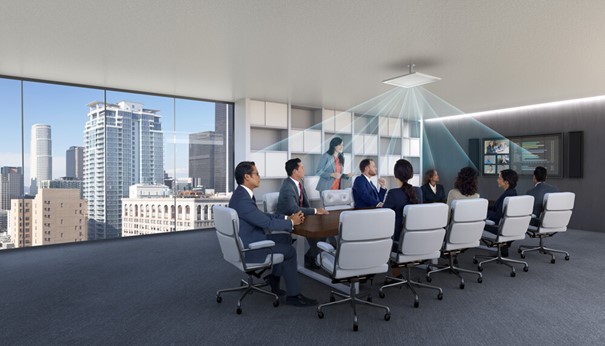Last update: 05/06/25
An effective videoconferencing room starts with a good layout of the videoconferencing equipment and furniture. Apart from the choice of the videoconference microphone, the basic principles must be respected: ergonomic table shape so that everyone can see and be seen by the remote site, no backlighting, suitable camera position and screen size, and finally a good sound system. It is on this last point that we would like to draw your attention.
The sound system requires well-sized speakers but also good microphones so that everyone can be heard properly. The symbolism of the meeting room microphone is strong: whoever has the microphone has the floor; they are sometimes highlighted in the layout of the room (for example, the beautiful microphones on the table of Jean-Jacques Bourdin’s daily show). However, current technologies tend to make microphones disappear or to make them more discreet, while improving their qualities.
If you want to know more about the use of collaborative meeting room microphones, we invite you to read the rest of this article 😉
As a designer and integrator of videoconferencing rooms, our role is to offer our customers solutions that combine technical performance and design, particularly for audio recording.
The manufacturers, Cisco, LifeSize, Polycom and others, supply surface microphones for videoconferencing, also known as table microphones, as standard with their codecs. They contain several capsules, arranged in such a way as to guarantee a 360° pick-up, with a given range and a pick-up geometry in space: the cardioid. In certain configurations, such as long tables, one microphone is not enough; it is then possible to add 1 or 2 additional microphones for video conferencing. The quality of these microphones is often excellent; they are optimised to ensure videoconferencing sessions in the best possible conditions.
Taking into consideration the constraints of layout, design and usage, in some cases we will recommend the use of other video conferencing microphones than those provided, such as wireless microphones, or ceiling microphones, such as those offered by Shure. This will be the case in rooms where participants:

As each project is different, the choice of microphones for audio meeting rooms will be made according to the criteria we have just mentioned: size of the room, number of participants, layout constraints, uses and… budget!
It is important to remember that each meeting scenario offers different challenges. While there is no one-size-fits-all solution, some factors are universal. When installing a videoconferencing room microphone, professionals should consider, among other things
Reviewing these basic principles will help you make an informed choice.
It is essential to consider discreet pickup systems that are adapted to the collaborative and unified environment when choosing your videoconferencing equipment. A pickup system can nowadays take the form of a standard ceiling tile (60cm square) that allows several sound pickup zones to be defined within a radius of several metres around the videoconference microphone. Each pick-up zone (lobe) can be defined and parameterised independently: width of the pick-up zone, gain, EQ, etc.
The effect of such an invisible microphone is to encourage exchanges – as in a traditional discussion – and to free up the most shy, as a video conference microphone can also intimidate certain employees, not necessarily the least competent. It is also noticeable that the “physical” behaviour of the participants is modified: they can move freely around the room, write on a board – with both hands free -, sway back and forth in their chair, have their laptop open, take notes… If properly configured, such a system allows the participants in a meeting to free themselves from the constraint represented until now by the use of “classic” microphones for meeting rooms.
And since we are talking about sound and since it is the most important element of a remote meeting (you can have a meeting without seeing each other, not without hearing each other), it is essential to make integrators and users aware of the absolute necessity of using a processor that handles AEC (Acoustic Echo Cancellation) in a videoconferencing room, as this will avoid the echo phenomena that are always destabilising during discussions. Many manufacturers now offer powerful meeting room microphone processors. The rule is simple: one AEC processing per microphone/lobe (for example: 8 channels of AEC processing for the Shure ceiling microphone).
The choice of the video conferencing microphone, its location and the layout of the meeting room are among the most important criteria when designing the video conferencing room. Micro ceilings complement the recent evolution of video conference rooms, video conferencing equipment and more widely collaborative workplaces. Freeing up behaviour means enriching the content of meetings and ultimately our productivity is the big winner.
Motilde offers a complete ecosystem of video conferencing equipment. We can meet all your videoconferencing needs based on an analysis of the uses you expect from this technology. Do not hesitate to contact us!